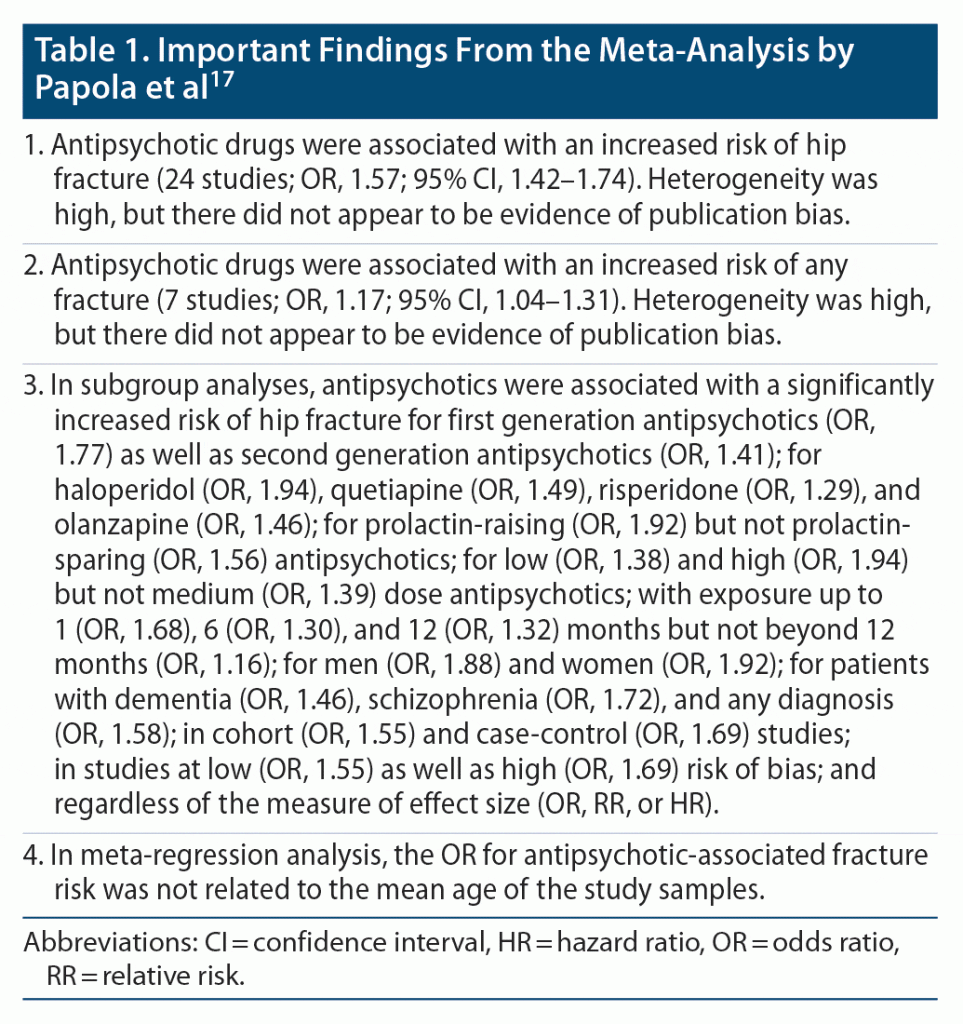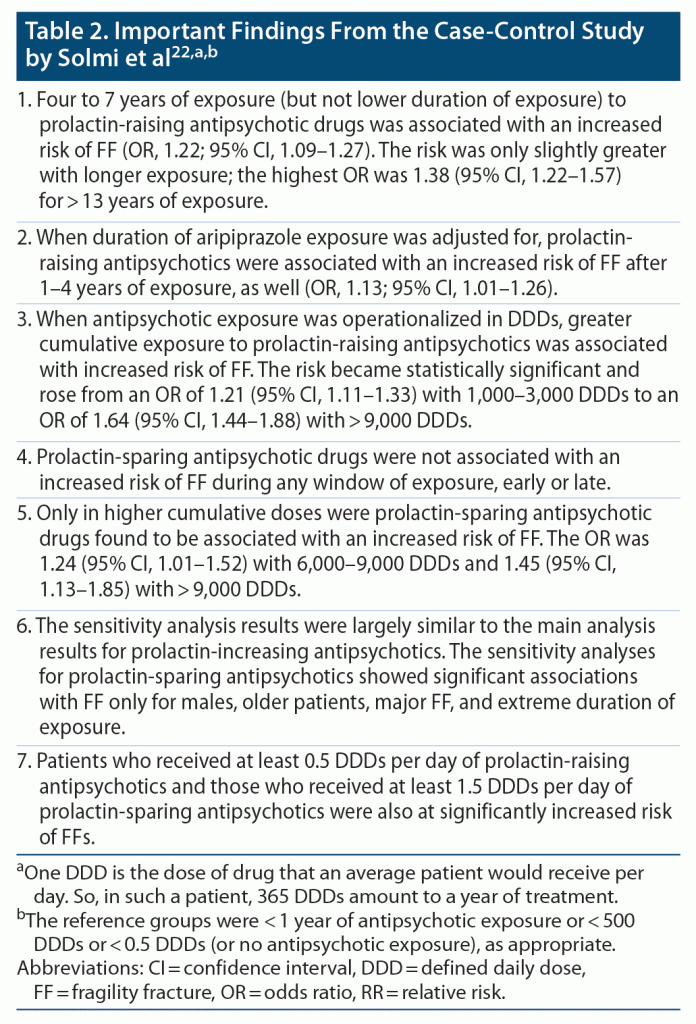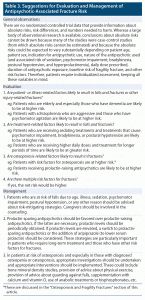ABSTRACT
Patients who require antipsychotic drug treatment are at increased risk of fractures, including osteoporosis-related fragility fractures, for reasons related to demographics, illness-related factors, and treatment-related factors. As examples, patients with dementia may be vulnerable to falls due to cognitive and psychomotor impairment, patients with schizophrenia may be vulnerable to injury related to physical restlessness or physical aggression, and patients receiving antipsychotics may suffer falls related to sedation, psychomotor impairment, bradykinesia, or postural hypotension. Antipsychotics may also increase the risk of fracture through long-term hyperprolactinemia and resultant osteoporosis. A meta-analysis of 36 observational studies conducted in mostly elderly samples found that antipsychotic exposure was associated with an increased risk of hip fracture as well as increased risk of any fracture; the findings were consistent in almost all subgroup analyses. An observational study that controlled for confounding by indication and illness severity found that fragility fractures in patients with schizophrenia were associated with higher daily doses, higher cumulative doses, longer duration of treatment, and prolactin-raising rather than prolactin-sparing antipsychotics; in patients receiving prolactin-raising antipsychotics, the concurrent use of aripiprazole appeared protective. The absolute risks of fracture are unknown and could vary depending on patient age, patient sex, indication for antipsychotic use, nature of the antipsychotic (and associated risk of sedation, psychomotor impairment, bradykinesia, and postural hypotension), daily dose prescribed, duration of antipsychotic exposure, baseline risk of fracture, and other risk factors. Patients should therefore be individually evaluated for risk factors for falls and fractures related to sociodemographic, clinical, and treatment-related risk factors. Patients identified to be at risk should be advised about risk-mitigating strategies. If prolactin-raising antipsychotics are required in the long term, prolactin levels should be monitored and prolactin-lowering strategies should be considered. Osteoporosis should be investigated and managed, if identified, to prevent fragility fractures.
J Clin Psychiatry 2023;84(1):23f14790
To cite: Andrade C. Prolactin-raising and prolactin-sparing antipsychotic drugs and the risk of fracture and fragility fracture in patients with schizophrenia, dementia, and other disorders. J Clin Psychiatry. 2023;84(1):23f14790.
To share: https://doi.org/10.4088/JCP.23f14790
© 2023 Physicians Postgraduate Press, Inc.
Prolactin, an anterior pituitary hormone, has many functions, the most obviously important being breast development and lactation in women. Dopamine inhibits the release of prolactin and antipsychotic drugs block dopamine receptors in the brain and elsewhere in the body; therefore, antipsychotic drugs that block dopamine receptors in the pituitary gland, which lies outside the blood-brain barrier, will increase prolactin levels. Some antipsychotic drugs, such as haloperidol and risperidone, raise serum prolactin, and in some patients even substantially so. Some drugs, such as clozapine and aripiprazole, have no effect on or may even lower serum prolactin.1–3
Adverse Effects Associated With Antipsychotic-Induced Hyperprolactinemia
Antipsychotic-induced hyperprolactinemia may be asymptomatic or may be associated with adverse effects such as decreased libido, erectile dysfunction, and gynecomastia in men and decreased libido, amenorrhea, infertility, breast engorgement, and lactation in women. Uncommon adverse events associated with long-term antipsychotic-induced hyperprolactinemia include an increased risk of breast cancer and an increased risk of bone fractures.4,5 A previous article in this column examined the association between prolactin-raising and -sparing antipsychotics and the risk of breast cancer.6 This article examines the association between prolactin-raising and -sparing antipsychotics and the risk of fragility fractures in patients with schizophrenia.
Osteoporosis and Fragility Fractures
A fragility fracture (FF), or a low energy fracture, is one that results from low energy trauma; that is, trauma, such as a fall from standing height or less, that would not be expected to result in a fracture in a healthy subject. Other descriptors for such fractures include osteoporotic fractures, pathological fractures, and spontaneous fractures; the last-mentioned term describes the occurrence of fracture in the absence of trauma. The hip, spine, and wrist are common sites of FFs. FFs occur in persons with osteoporosis, a condition characterized by low bone mass and microarchitectural deterioration of bone tissue.7
Osteoporosis is most commonly associated with old age and female sex but can also occur in association with, for example, lifestyle factors such as smoking, alcohol intake, low physical activity, and low calcium and vitamin D content in diet; medical conditions such as vitamin D deficiency and endocrine disease; and use of drugs such as glucocorticoids and treatments for cancer.8,9 Osteoporosis may also result from long-term hyperprolactinemia, probably through reduction in sex hormone levels.10,11 Relevant to the present article, antipsychotic drugs that raise prolactin levels have been associated with reduced bone mineral density (BMD) and osteoporosis.
Schizophrenia, Antipsychotic Drugs, and Osteoporosis
BMD is reduced in schizophrenia, more so in patients receiving prolactin-raising than in those receiving prolactin-sparing antipsychotics. The reduced BMD is observed at sites such as the hip and spine; that is, sites known to be vulnerable to FF.12,13 It is likely that schizophrenia diagnosis and schizophrenia treatment are independently associated with the osteoporosis risk; the diagnosis, through poor sunlight exposure, poor diet, physical inactivity, smoking, polydipsia, and other risk factors, and the treatment, through hyperprolactinemia.14 The diagnosis-related risks are important to recognize because, in any study that examines the association between antipsychotic drugs and fracture risk, confounding by indication must be considered, with poor sunlight exposure, poor diet, physical inactivity, smoking, polydipsia, and other risk factors as the confounding variables.
Why Confounding by Indication Is Important
For the association between antipsychotic exposure and fracture risk, confounding by indication can also arise in other contexts; that is, contexts other than osteoporosis. The importance of confounding by indication is demonstrated by studies that showed a lower (not higher) risk of fracture after antipsychotic initiation. As an example, in a Swedish study of elderly subjects (mean age, 82 years; n = 255,274), in adjusted analyses antipsychotic exposure was associated with an increased risk of hip fracture during all time frames from 1 year before antipsychotic initiation to 1 year after antipsychotic initiation; however, the highest risk was observed 16–30 days before antipsychotic initiation (odds ratio [OR], 9.09; 95% confidence interval [CI], 7.00–11.81); this risk progressively dropped, reaching 2.86 (95% CI, 2.40–3.39) in the 6–12 months after antipsychotic initiation. The findings were consistent in subgroup analyses based on age (cutoff, 85 years) and for conventional and atypical antipsychotics, separately.15 The findings of this study prompt the speculation that illness symptoms necessitating antipsychotic use may drive at least part of the risk of fractures. A strange but important limitation of this study is that the indication(s) for use of antipsychotics was not stated.
In another study of 6,624 children (mean age, 11 years) with autism spectrum disorder, the risk of fracture was significantly lower in children receiving risperidone than in an equal number of propensity-matched children receiving aripiprazole (hazard ratio [HR], 0.60; 95% CI, 0.44–0.83).16 Because risperidone is prolactin-raising whereas aripiprazole is prolactin-sparing, this implicates mechanisms other than prolactin in the cause of the fractures and in the protection therefrom. As an example, in this sample, illness behaviors that were risk factors for fracture may have responded better to risperidone than to aripiprazole.
Antipsychotic Drugs and Fracture Risk: Meta-Analysis
Papola et al17 described a systematic review and meta-analysis of observational studies that examined the risk of fracture in persons exposed to antipsychotic drugs. These authors searched electronic databases, reference lists, and other sources and identified 16 cohort studies and 20 case-control studies that met their study selection criteria. Most of the studies had been conducted in Europe or North America. Most of the studies were at low risk of bias. The studies had been conducted in persons with dementia (n = 7), schizophrenia (n = 3), and Parkinson disease or parkinsonism (n = 2); the rest were conducted in samples with mixed diagnoses. The mean age of the samples was ≥ 65 years in all but 5 studies. Only 10 studies examined the occurrence of any fracture; the remaining 26 studies focused specifically on hip fracture. The pooled sample included 6,840,163 persons who had been exposed to antipsychotics; among these, 448,368 had experienced fracture.
Important findings from the meta-analysis are presented in Table 1. In summary, antipsychotic exposure was associated with an increased risk of hip fracture as well as increased risk of any fracture, and the findings were consistent in almost all subgroup analyses. The only exceptions were for prolactin-sparing antipsychotics, for medium antipsychotic doses, and for duration of exposure > 12 months. Given that most of the studies in this meta-analysis were conducted in the elderly, and given that most of the studies focused on hip fracture, it is reasonable to consider that the findings of the meta-analysis largely address the relationship between antipsychotic exposure and FFs.
The exception for prolactin-sparing antipsychotics is understandable; drugs that do not raise serum prolactin are less likely to be associated with osteoporosis and FF. The exception for medium antipsychotic doses may have been related to inadequate statistical power; the OR was actually (marginally) higher with medium doses than with low doses.
The exception for duration of exposure > 12 months was interesting because durations of exposure of up to 1 month (3 studies), up to 6 months (3 studies), and up to 12 months (4 studies) were all associated with significantly higher risk whereas exposure beyond 12 months (4 studies) was not. Now, we do not expect osteoporosis-related FF to emerge after very brief durations of antipsychotic exposure. So, the early risk may have been due to confounding by indication (as discussed in an earlier section) or to antipsychotic-induced sedation, psychomotor impairment, bradykinesia, or postural hypotension, all of which are associated with an increased risk of falls. In this context, all the studies that contributed data to duration of exposure had been conducted in patients with dementia, and so mechanisms related to sedation, psychomotor impairment, bradykinesia, and hypotension are more likely to have been relevant.
Antipsychotic Drugs and Fracture Risk: Recent Studies
Several studies were published after this meta-analysis.17 For example, in a study of the US Truven MarketScan Medicare Supplemental database, Ramcharran et al18 found that, in older adults who were receiving atypical antipsychotics, there were significantly elevated risks of falls, as well as of nonvertebral osteoporotic fracture, hip fracture, and any fracture. However, after implementing strategies that addressed confounding, none of the associations remained statistically significant.
In a nested case-control study of new users of antipsychotics (n = 340,948), based on claims data from the Taiwan National Health Insurance Research Database, Shen et al19 identified 2,832 hip/femur fractures and 2,693 other fractures. Crude rates for hip/femur fractures and non-hip/femur per 100,000 person-years were 637 and 564 for risperidone, 886 and 701 for other atypical antipsychotics, and 519 and 689 for typical antipsychotics across a mean duration of follow-up of about 1.0–1.6 years. After adjusting for confounding variables, the HRs did not differ significantly for atypical or typical antipsychotics vs risperidone for either for hip/femur fractures or for non-hip/femur fractures. Likewise, after adjusting for confounding variables, the ORs did not differ significantly for atypical or typical antipsychotics vs risperidone for either hip/femur fractures or other fractures for antipsychotic exposure during time intervals of up to 1 year, 1–3 years, and 3–5 years before the fracture date.
Weaver et al20 compared 6,388 antipsychotic-exposed subjects with 6,385 unexposed subjects at a single US Veterans Affairs medical center; the fracture rate did not differ significantly between the 2 groups (0.55 vs 0.48 per 10,000 patient-days, respectively). It is difficult to interpret these results because the authors did not present data on duration of antipsychotic exposure nor did they adjust the analysis for risk factors.
Clapham et al21 described a population-based Swedish study that examined the risk of osteoporosis-related closed fractures at the hip or femur in the context of exposure to risperidone (n = 38,211) or typical antipsychotics (n = 17,445) relative to atypical antipsychotics excluding paliperidone (n = 60,691). In adjusted analyses, risperidone was not associated with increased risk (HR, 1.04, 95% CI, 0.91–1.19); however, the risk was elevated with typical antipsychotics (HR, 1.24; 95% CI, 1.07–1.45). The findings were similar in analyses restricted to treatment-naive patients. The risks with typical antipsychotics were more apparent in older age groups. For fractures other than those at the hip/femur, neither risperidone nor typical antipsychotics were associated with increased risk.
A common theme in the studies reviewed in this section is that, after adjusting for confounding variables, antipsychotic-associated risk of fracture lost statistical significance, and that this even appeared to apply to prolactin-raising antipsychotics such as risperidone, relative to other antipsychotics.
Antipsychotic Drugs and Fracture Risk: Controlling for Confounding by Indication
Solmi et al22 described a nationwide Finnish nested case-control study of FF associated with prolactin-increasing and -sparing antipsychotics in patients who had been hospitalized at least once with schizophrenia or schizoaffective disorder. The data were drawn from nationwide medical registers in Finland for the years 1972–2014. Cases comprised 4,960 schizophrenia patients, aged 16–85 years, who experienced FF after schizophrenia onset; attempts were made to exclude patients who suffered fractures with potentially external causes. FF was considered to be major in 72% of cases. The mean age of the sample was 62 years. The sample was 62% female. The mean duration of illness was about 22 years. Each case was matched with 5 controls, without FF, based on age, sex, and illness duration; there were 24,451 controls.
The most commonly prescribed antipsychotics were risperidone, olanzapine, levomepromazine, thioridazine, and perphenazine. Clozapine, quetiapine, and aripiprazole were the prolactin-sparing antipsychotics; other antipsychotics were the prolactin-raising antipsychotics. The odds of antipsychotic exposure were compared in patients with vs without FF. The reference groups were < 1 year of antipsychotic exposure, or < 500 defined daily doses (DDDs), or no antipsychotic exposure, as appropriate. Analyses were adjusted for medical and neurologic comorbidities, current (other) psychotropic drug use, and use of hormone replacement therapy, but not bisphosphonate use.
Important findings from the study are presented in Table 2. In summary, this case-control study22 found significant dose-dependent associations between exposure to prolactin-raising antipsychotics and FF in patients with schizophrenia; however, the associations became statistically significant only with > 4 years of exposure (but earlier, at 1–4 years, when concurrent aripiprazole exposure was removed). For prolactin-sparing antipsychotics, associations were significant only for males, older patients, major FF, and extreme duration of exposure. For both prolactin-raising and prolactin-sparing antipsychotics, higher daily doses were associated with greater risk.
This study22 had 2 important strengths. The first is that this is the only study in the field to not only control for confounding by indication but also control for confounding by illness severity; this was effected by limiting recruitment to patients with schizophrenia and schizoaffective disorder, and specifically those who had had at least 1 period of inpatient care. The second was that the study better focused on longer-term risks because antipsychotic exposures of interest were exposures of > 1 year duration or > 500 DDDs (365 DDDs approximate 1 year of treatment). Patients vulnerable to FFs resulting from falls related to sedation, psychomotor impairment, bradykinesia, and postural hypotension would probably experience these FFs early during the course of treatment and would be less likely to be represented among those who experienced FFs after longer periods of exposure. Therefore, FFs related to longer periods of exposure would have been more likely to have arisen from osteoporotic events.
An inescapable limitation of this study22 is that control for severity of illness was imperfect because patients who were treated with prolactin-raising antipsychotics (especially typical antipsychotics, or risperidone or paliperidone long-acting injections) may have been more severely ill, and because patients who required higher doses and longer durations of treatment may likewise have been more severely ill. The same FF risk factors implicated in confounding by indication are implicated in confounding by severity of indication. These risk factors, as earlier stated, are smoking, drinking, poor diet, inadequate exercise, inadequate sunlight exposure, polydipsia, and others. Importantly, the effects of these risk factors could cumulate across time and may have driven the risk of FFs more than did cumulative exposure to antipsychotic drugs.
In conclusion, this study22 provides the best evidence to date that exposure, and especially long-term exposure, to antipsychotics, and especially prolactin-raising antipsychotics, is associated with an increased risk of FFs and that the use of aripiprazole concurrent with prolactin-raising antipsychotics may have a protective effect. However, a causal role for antipsychotics remains unproven.
How Large Is the Antipsychotic-Associated Fracture Risk?
When absolute risk, relative risk (RR), and number needed to harm (NNH)23,24 are estimated from randomized controlled trials (RCTs), the values obtained are reasonably trustworthy to the extent that the study has internal and external validity.25 However, for many reasons these parameters cannot be properly estimated from cohort and case-control studies. These reasons are explained below.
In cohort studies, we can obtain information on how many persons were vs were not exposed to antipsychotic drugs, among whom how many did vs did not experience fracture. We can then calculate the percentage of persons who experienced fracture in those who were exposed and in those who were unexposed, we can subtract these percentages to estimate the extent to which fractures were more common in persons who were exposed, and we can even use these numbers to derive the RR and NNH, as we do in RCTs. However, such derivations are wrong because the values that we obtain from such calculations are not comparable with values obtained from RCTs. In cohort studies, patients are not randomized to antipsychotic-exposed vs unexposed groups; so, the risk of fracture is formed not only from the risk associated with antipsychotic exposure but also from risks associated with confounding by indication and confounding by illness severity, as discussed in earlier sections. Furthermore, in cohort studies, different persons would have entered the study at different times and exited at different times; so, at study endpoint, for some patients the duration of exposure may not have been sufficiently long for fracture as an adverse event to have happened, and for other patients, the duration of exposure may have been so long as to allow other risk factors (eg, age) to result in fracture.
The above notwithstanding, in cohort studies risks can be compared between groups of interest using Cox proportional hazards regression.26,27 This statistical procedure takes into consideration the different durations that different subjects spend in the study, it permits adjustment for measured (but not unmeasured and unknown) confounding variables, and it provides a hazard ratio (HR) that is interpreted in much the same manner as an RR. In this context, in a subgroup analysis buried in a supplementary data file, Papola et al17 identified 4 retrospective cohort studies that reported the HR. These studies had been conducted between 2010 and 2015. The 4 studies included 72,026 subjects who had been exposed to antipsychotic drugs and 72,026 controls with no antipsychotic exposure. The subjects in the studies were mostly elderly. In these 4 studies, the pooled HR for (mostly) hip fracture was 1.69 (95% CI, 1.21–2.36).
In case-control studies, absolute and relative risks cannot be estimated at all. This is because of the study design: patients with (cases) and without (controls) fractures are matched, and we look back in time to see how many persons among the cases and how many persons among the controls had vs had not been exposed to antipsychotic drugs. The odds ratio is then calculated. The RR cannot be calculated because of how we started the study: we only have data on how many persons who did vs did not have fracture (the sample) were vs were not exposed to antipsychotics; we do not have data on how many persons who were vs were not exposed to antipsychotics went on to develop (or not develop) fractures. So, no conclusions about absolute and relative risks can be drawn from the case-control study of Solmi et al.22
Papola et al17 noted that, in 24 studies, the percentage of subjects with hip fracture was 6.4% vs 5.5% in antipsychotic-exposed vs unexposed subjects and that, in 7 studies, the percentage of subjects with any fracture was 5.2% vs 4.2% in exposed vs unexposed subjects. For reasons explained above, and because these percentages are further compromised by the mixing of cohort with case-control studies, we cannot draw any conclusions about absolute and relative risks from these percentages, nor can we compute NNH values.
Implications for Patient Care
The studies examined in this article suggest many conclusions. Patients who need antipsychotics are at increased risk of fracture and FF before initiation of treatment and in the early period after initiation of treatment (especially in patients with dementia), as well as many years after initiation of treatment. The risks appear greater with higher daily doses, with higher cumulative doses, with longer duration of treatment, and with prolactin-raising rather than prolactin-sparing antipsychotics. In patients who are receiving prolactin-raising antipsychotics, the concurrent use of aripiprazole may be protective. Implications and suggestions for evaluation and management are provided in Table 3.
Parting Notes
Antipsychotic drugs are not the only pharmacologic agents that have been associated with FFs. In a systematic review and meta-analysis, Mortensen et al28 found that antidepressants (7 studies), antiparkinsonian drugs (4 studies), anxiolytic drugs (6 studies), benzodiazepines (8 studies), sedatives (2 studies), systemic corticosteroids (14 studies), thyroid hormones (5 studies), H2 receptor antagonists (5 studies), and proton pump inhibitors (5 studies) were all associated with an increased risk of FF at the hip; ORs ranged from 1.21 with H2 receptor antagonists to 2.36 with antiparkinsonian drugs. Inhaled corticosteroids (3 studies), anticoagulant drugs (2 studies), statins (5 studies), and nonsteroidal anti-inflammatory drugs (2 studies) were not associated with a significantly increased risk.
In this meta-analysis,28 antipsychotic drugs were also associated with an increased risk of FF at the hip (8 studies; OR, 1.85; 95% CI, 1.36–2.51; note that these values, taken from the text and table, do not match with the values stated in the abstract). Hormone replacement therapy was expectedly associated with lower risk (12 studies; OR, 0.80; 95% CI, 0.65–0.98). Curiously, thiazide diuretics were associated with a very small but statistically significantly lower risk (12 studies; OR, 0.97; 95% CI, 0.94–0.99), loop diuretics with a higher risk (4 studies; OR, 1.88; 95% CI, 1.08–3.28), and other antihypertensive drugs with a nonsignificantly higher risk (3 studies; OR, 1.20; 95% CI, 0.95–1.51).
Plausible mechanisms related to disturbed bone metabolism may explain the associations of FFs with drugs such as antipsychotics and systemic corticosteroids. Indirect mechanisms, such as a predisposition to falls resulting from sedation, psychomotor impairment, or postural hypotension, may be responsible in the case of drugs such as certain antidepressants, benzodiazepines, and sedatives. Finally, confounding by indication may explain associations with antiparkinsonian and other neuropsychiatric drugs. As examples, patients who receive antiparkinsonian drugs for Parkinson disease may suffer falls related to gait disturbance and patients who receive antipsychotics for behavioral and psychological symptoms of dementia may have age-related osteoporosis and may suffer falls related to frailty. Thus, in such patients, FFs result from events, such as falls, related to the diagnosis rather than events related to the drugs used to treat the diagnosis.
Published online: January 30, 2023.
 Each month in his online column, Dr Andrade considers theoretical and practical ideas in clinical psychopharmacology with a view to update the knowledge and skills of medical practitioners who treat patients with psychiatric conditions.
Each month in his online column, Dr Andrade considers theoretical and practical ideas in clinical psychopharmacology with a view to update the knowledge and skills of medical practitioners who treat patients with psychiatric conditions.
Department of Clinical Psychopharmacology and Neurotoxicology, National Institute of Mental Health and Neurosciences, Bangalore, India (candrade@psychiatrist.com).
Financial disclosure and more about Dr Andrade.
References (28)

- Andrade C. Low-dose amisulpride and elevation in serum prolactin. J Clin Psychiatry. 2013;74(6):e558–e560. PubMed CrossRef
- Zhu Y, Zhang C, Siafis S, et al. Prolactin levels influenced by antipsychotic drugs in schizophrenia: a systematic review and network meta-analysis. Schizophr Res. 2021;237:20–25. PubMed CrossRef
- Krøigaard SM, Clemmensen L, Tarp S, et al. A meta-analysis of antipsychotic-induced hypo- and hyperprolactinemia in children and adolescents. J Child Adolesc Psychopharmacol. 2022;32(7):374–389. PubMed CrossRef
- Maguire GA. Prolactin elevation with antipsychotic medications: mechanisms of action and clinical consequences. J Clin Psychiatry. 2002;63(suppl 4):56–62. PubMed
- Bostwick JR, Guthrie SK, Ellingrod VL. Antipsychotic-induced hyperprolactinemia. Pharmacotherapy. 2009;29(1):64–73. PubMed CrossRef
- Andrade C. Understanding the limitations of the odds ratio in a case-control study of the association between breast cancer and exposure to antipsychotic drugs. J Clin Psychiatry. 2021;82(6):21f14319. PubMed CrossRef
- van Oostwaard M. Osteoporosis and the nature of fragility fracture: an overview. In: Hertz K, Santy-Tomlinson J, eds. Fragility Fracture Nursing: Holistic Care and Management of the Orthogeriatric Patient [Internet]. Published June 16, 2018. Springer; 2018. https://www.ncbi.nlm.nih.gov/books/NBK543829/
- Zhu J, March L. Treating osteoporosis: risks and management. Aust Prescr. 2022;45(5):150–157. PubMed CrossRef
- Drake MT. Osteoporosis and cancer. Curr Osteoporos Rep. 2013;11(3):163–170. PubMed CrossRef
- Samperi I, Lithgow K, Karavitaki N. Hyperprolactinaemia. J Clin Med. 2019;8(12):2203. PubMed CrossRef
- di Filippo L, Doga M, Resmini E, et al. Hyperprolactinemia and bone. Pituitary. 2020;23(3):314–321. PubMed CrossRef
- Tseng PT, Chen YW, Yeh PY, et al. Bone mineral density in schizophrenia: an update of current meta-analysis and literature review under guideline of PRISMA. Medicine (Baltimore). 2015;94(47):e1967. PubMed CrossRef
- Gomez L, Stubbs B, Shirazi A, et al. Lower bone mineral density at the hip and lumbar spine in people with psychosis versus controls: a comprehensive review and skeletal site-specific meta-analysis. Curr Osteoporos Rep. 2016;14(6):249–259. PubMed CrossRef
- Andrade C, Bhakta SG, Singh NM. Schizophrenia, osteoporosis, and an examination of the risk of fractures in patients receiving ECT. J ECT. 2007;23(4):219–220. PubMed CrossRef
- Brännström J, Lövheim H, Gustafson Y, et al. Antipsychotic drugs and hip fracture: associations before and after the initiation of treatment. J Am Med Dir Assoc. 2020;21(11):1636–1642.e6. PubMed CrossRef
- Houghton R, van den Bergh J, Law K, et al. Risperidone versus aripiprazole fracture risk in children and adolescents with autism spectrum disorders. Autism Res. 2021;14(8):1800–1814. PubMed CrossRef
- Papola D, Ostuzzi G, Thabane L, et al. Antipsychotic drug exposure and risk of fracture: a systematic review and meta-analysis of observational studies. Int Clin Psychopharmacol. 2018;33(4):181–196. PubMed CrossRef
- Ramcharran D, Qiu H, Schuemie MJ, et al. Atypical antipsychotics and the risk of falls and fractures among older adults: an emulation analysis and an evaluation of additional confounding control strategies. J Clin Psychopharmacol. 2017;37(2):162–168. PubMed CrossRef
- Shen SP, Liu Y, Qiu H, et al. The risk of bone fracture after long-term risperidone exposure is not increased compared to other atypical antipsychotics: A retrospective cohort study. PLoS One. 2019;14(9):e0221948. PubMed CrossRef
- Weaver J, Kawsky J, Corboy A. Antipsychotic use and fracture risk: an evaluation of incidence at a Veterans Affairs medical center. Ment Health Clin. 2019;9(1):6–11. PubMed CrossRef
- Clapham E, Bodén R, Reutfors J, et al. Exposure to risperidone versus other antipsychotics and risk of osteoporosis-related fractures: a population-based study. Acta Psychiatr Scand. 2020;141(1):74–83. PubMed CrossRef
- Solmi M, Lähteenvuo M, Correll CU, et al. Antipsychotic use and risk of low-energy fractures in people with schizophrenia: a nationwide nested case-control study in Finland. Schizophr Bull. 2023;49(1):78–89. PubMed CrossRef
- Andrade C. Understanding relative risk, odds ratio, and related terms: as simple as it can get. J Clin Psychiatry. 2015;76(7):e857–e861. PubMed CrossRef
- Andrade C. The numbers needed to treat and harm (NNT, NNH) statistics: what they tell us and what they do not. J Clin Psychiatry. 2015;76(3):e330–e333. PubMed CrossRef
- Andrade C. Internal, external, and ecological validity in research design, conduct, and evaluation. Indian J Psychol Med. 2018;40(5):498–499. PubMed CrossRef
- Spruance SL, Reid JE, Grace M, et al. Hazard ratio in clinical trials. Antimicrob Agents Chemother. 2004;48(8):2787–2792. PubMed CrossRef
- Deo SV, Deo V, Sundaram V. Survival analysis-part 2: Cox proportional hazards model. Indian J Thorac Cardiovasc Surg. 2021;37(2):229–233. PubMed CrossRef
- Mortensen SJ, Mohamadi A, Wright CL, et al. Medications as a risk factor for fragility hip fractures: a systematic review and meta-analysis. Calcif Tissue Int. 2020;107(1):1–9. PubMed CrossRef
This PDF is free for all visitors!
Save
Cite






